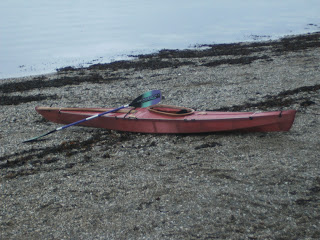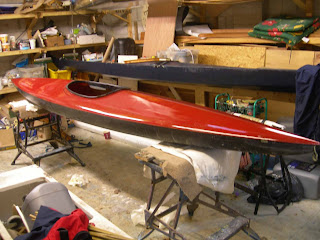launch 2
Recap
The design brief
The
original brief, for a customer who was looking for a kayak to enable
him to improve his skills, was to build a copy of Brian Schultz’s
F1. When it was clear that this was not possible, my proposal to
design and build a “british” version of the Mariner Coaster (on
which the F1 is based) was accepted. Only 13’ 6’’ in length,
the Coaster was the first sea going “playboat”, a kayak for
surfing, rock dodging, tide races, light camping and touring;
essentially a day boat.
This
14 ft “british” version was designed with a lower profile for a
windier environment with smaller waves than the Western US coastline
from where the Coaster originated. The name Lowen – Cornish for
“joyful” seemed right.
Looking back on the first trial paddle
Much
of the feedback from the first day showed that the Lowen performed to
these specifications: slightly tippy with good secondary stability that enabled effective steering through secure edging, no weather-cocking
tendencies – this was important for a kayak without a skeg, good
tracking, acceptable cruising speed, good enough steerage downwind
and promising surfing performance.
The
main problem was the tendency to pitch and bounce into a chop. This
besides being uncomfortable and slowing the boat, also allowed the
bow to drift off to leeward when paddling close to the wind F4
upwards.
It was clear that the seat could go forward by about an inch, this would not only improve upwind performance but also assist the fit of a shorter person (less than 6’ 1/2’’) under the thigh brace. This done the second trial was conducted in the Carrick Roads, a deep water estuary, launching about five miles inland for the entrance into the Western Approaches.
It was clear that the seat could go forward by about an inch, this would not only improve upwind performance but also assist the fit of a shorter person (less than 6’ 1/2’’) under the thigh brace. This done the second trial was conducted in the Carrick Roads, a deep water estuary, launching about five miles inland for the entrance into the Western Approaches.
Launching a second time
The wind, blowing NW f4 was channelled straight down the Estuary towards the sea; so that on launching - from the west side of the estuary, there was no sign of the wind. As can be seen from the photograph taken as it was starting to rain, this time I was using a short pair (200cm) of conventional paddles rather than greenland as on the previous trip. Normally used for surfing, I am able to roll confidently with them and I wanted to see how the boat would perform with a more powerful motor.
I made a circular paddle of the roads first up towards the Fal and then across and down feeling the increasing wind on the exposed side to just short of St Mawes. Paddling back upwind, crossing to Windy ridge to the south of the Mylor harbour approach (which as usual lived up to it's name) and then up the West side back to Loe beach, I mostly paddled through the slack of low water.
Steerage through edging was again good on all points with the exception of wind and waves on the quarter. I was not particularly concerned as I have found this to be a problematic in most of the boats I have paddled without a rudder. The kayak either wants to point fully downwind or across the wind and the paddler has persuade the boat to stay between the two through reacting to the waves as they come through. The main thing is to keep the boat moving even if off course a little.
What happened was that I had good sections where the boat kept course - and even gave me a few diagonal surfs, and then sooner or later the control would start to go and the boat would move around somewhat until back in the groove. A stern rudder was rarely used; always a last resort, particularly a forceful one for it always slows the boat. Downwind I have consistently found that it is both quicker and more enjoyable to focus on keeping the kayak moving with an overview rather than a narrow focus on direction.
Into the wind and chop the there was less tendency to pitch with the seat moved forward, and the tendency to drift off with the wind just off the bow hardly noticeable (although the wind did not go much above f4), however the ride was a little more wet. I was pushing the boat much harder this time with the more powerful paddles and also when I realized that I was likely to be late getting home yet again. A most enjoyable paddle.
I think this boat goes at its best when pushed hard. It really brings out the liveliness - that slight spring that comes from the wooden frame allied with fabric. That is what skin on frame boats are about: they are aesthetically satisfying.
Steerage through edging was again good on all points with the exception of wind and waves on the quarter. I was not particularly concerned as I have found this to be a problematic in most of the boats I have paddled without a rudder. The kayak either wants to point fully downwind or across the wind and the paddler has persuade the boat to stay between the two through reacting to the waves as they come through. The main thing is to keep the boat moving even if off course a little.
What happened was that I had good sections where the boat kept course - and even gave me a few diagonal surfs, and then sooner or later the control would start to go and the boat would move around somewhat until back in the groove. A stern rudder was rarely used; always a last resort, particularly a forceful one for it always slows the boat. Downwind I have consistently found that it is both quicker and more enjoyable to focus on keeping the kayak moving with an overview rather than a narrow focus on direction.
Into the wind and chop the there was less tendency to pitch with the seat moved forward, and the tendency to drift off with the wind just off the bow hardly noticeable (although the wind did not go much above f4), however the ride was a little more wet. I was pushing the boat much harder this time with the more powerful paddles and also when I realized that I was likely to be late getting home yet again. A most enjoyable paddle.
I think this boat goes at its best when pushed hard. It really brings out the liveliness - that slight spring that comes from the wooden frame allied with fabric. That is what skin on frame boats are about: they are aesthetically satisfying.



Chris, do you run kayak building courses as I like the look of the Lowen, or sell plans.
ReplyDeleteRegards.
Chris R